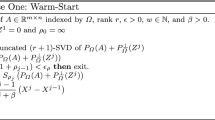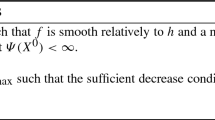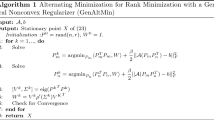Abstract
In this article, we propose a new method for low-rank completion of a large sparse matrix, subject to non-negativity constraint. As a challenging prototype of this problem, we have in mind the well-known Netflix problem. Our method is based on the derivation of a constrained gradient system and its numerical integration. The methods we propose are based on the constrained minimization of a functional associated to the low-rank completion matrix having minimal distance to the given matrix. In the main 2-level method, the low-rank matrix is expressed in the form of the non-negative factorization X = εUVT, where the factors U and V are assumed to be normalized with unit Frobenius norm. In the inner level—for a given ε—we minimize the functional; in the outer level, we tune the parameter ε until we reach a solution. Numerical experiments on well-known large test matrices show the effectiveness of the method when compared with other algorithms available in the literature.
Similar content being viewed by others
References
Ang, A.M.S., Gillis N.: Accelerating nonnegative matrix factorization algorithms using extrapolation. arXiv:1805.06604 (2018)
Ang, A.M.S., Gillis N.: Algorithms and comparisons of non-negative matrix factorization with volume regularization for hyperspectral unmixing. arXiv:1903.04362 (2019)
Bennet, J., Lanning, S.: The netflix prize. In: Proceedings of the KKD cup and workshop. San Jose, CA, USA, 12 August 2007, pp. 35 (2007)
Berman, A., Plemmons, R.J.: Nonnegative matrices in the mathematical sciences. Classics in Applied Mathematics Society for Industrial and Applied Mathematics (SIAM), Philadelphia (1994)
Brand, M.: Incremental singular value decomposition of uncertain data with missing values. In: European conference on computer vision. Lecture Notes in Computer Science, vol. 2350, pp 707–720. Springer, Berlin (2002)
Cai, J.F., Candés, E.J., Shen, Z.: A singular value thresholding algorithm for matrix completion. SIAM J. Optim. 20, 1956–1982 (2010)
Cambier, L., Absil, P.A.: Robust low-rank matrix completion by riemannian optimization. SIAM J. Sci. Comput. 38, 440–460 (2016)
Chen, D., Plemmons, R.J.: Nonnegativity constraints in numerical analysis. The Birth of Numerical Analysis, pp. 109–139 (2009)
Candés adn, E.J., Recht, B.: Exact matrix completion via convex optimization. Foundations of Comput. Math. 9, 717–772 (2009)
Ding, Y., Krislock, N., Qian, J., Wolkowicz, H.: Sensor network localization, euclidean distance matrix completions, and graph realization. Optim. Eng. 11, 45–66 (2010)
Fletcher, R.: Practical methods of optimization. Wiley, New York (2013)
Gillis, N., Glineur, F.: Low-rank matrix approximation with weights or missing data is NP-hard. SIAM J. Matrix Anal. Appl. 4, 1149–1165 (2011)
Gillis, N., Glineur, F.: On the geometric interpretation of non-negative rank. Linear Algebra and its Applications 437, 2685–2712 (2012)
Goldberg, D., Nichols, D., Oki, B.M., Terry, D.: Using collaborative filtering to weave an information tapestry. Commun. ACM 35, 61–70 (1992)
Gillis, N., Plemmons, R.J.: Sparse nonnegative matrix underapproximation and its application to hyperspectral image analysis. Linear Algebra and its Applications 438, 3991—4007 (2013)
Guglielmi, N., Lubich, C.: Low-rank dynamics for computing extremal points of real pseudospectra. SIAM J. Matrix Anal. Appl. 34, 40–66 (2013)
Guglielmi, N., Lubich, C.: Differential equations for roaming pseudospectra: paths to extremal points and boundary tracking. SIAM J. Matrix Anal. Appl. 49, 1194–1209 (2011)
Guglielmi, N., Lubich, C., Mehrmann, V.: On the nearest singular matrix pencil. SIAM J. Matrix Anal. Appl. 38, 776–806 (2017)
Jawanpuria, P., Mishra, B.: Structured low-rank matrix learning: algorithms and applications. arXiv:1704.07352 (2018)
Kennedy, R., Balzano, L., Wright, S.J., Taylor, C.J.: Online algorithms for factorization-based structure from motion. Comput. Vis. Image Underst. 150, 139–152 (2016)
Koch, O., Lubich, C.: Dynamical low-rank approximation. SIAM J. Matrix Anal. Appl. 29, 434–454 (2007)
Markovsky adn, I., Usevich, K.: Structured low-rank approximation with missing data. SIAM J. Matrix Anal. Appl. 34, 814–830 (2013)
Mitra, K., Sheorey, S., Chellappa, R.: Large-scale matrix factorization with missing data under additional constraints. Advances in neural information processing systems 23: 24th Annual Conference on Neural Information Processing Systems, pp. 1651–1659 (2010)
Padoan, R., Steemers, A.G., Klein, M.E., Aalderink, B., Bruin, G.de.: Quantitative Hyperspectral imaging of hystorical documents: Technique and applications. 9th International Conference on NDT of Art, Jerusalem Israel, 25–30 May 2008 (2008)
Scalone, C., Guglielmi, N.: A gradient system for low rank matrix completion. Axioms 7, 51 (2018)
Xu, Y., Yin, W., Wen, Z., Yin, W.: An alternating direction algorithm for matrix completion with nonnegative factors. Frontiers of Mathematics in China 7, 365–384 (2012)
Vandereycken, B.: Low-rank matrix completion by Riemaniann optimization. SIAM J. Optim. 23, 367–384 (2013)
Acknowledgments
The authors thank Pratik Jawanpuria and Bamdev Mishra for providing us valuable informations about the correct use of their code (see [19]). The authors also thank the anonymous referees for their valuable remarks; in particular, for suggesting the comparison with the SVT method of [6]. The MATLAB codes implementing the methods described in this article are available upon request to the authors.
Funding
The first author thanks the INdAM GNCS (Gruppo Nazionale di Calcolo Scientifico) for financial support and Italian MIUR (PRIN 2017 project “Discontinuous dynamical systems: theory, numerics and applications.”
Author information
Authors and Affiliations
Corresponding author
Additional information
Communicated by: Lothar Reichel
Publisher’s note
Springer Nature remains neutral with regard to jurisdictional claims in published maps and institutional affiliations.
Rights and permissions
About this article
Cite this article
Guglielmi, N., Scalone, C. An efficient method for non-negative low-rank completion. Adv Comput Math 46, 31 (2020). https://doi.org/10.1007/s10444-020-09779-x
Received:
Accepted:
Published:
DOI: https://doi.org/10.1007/s10444-020-09779-x




